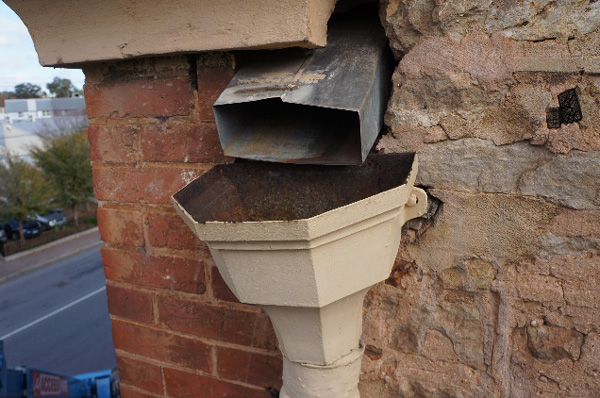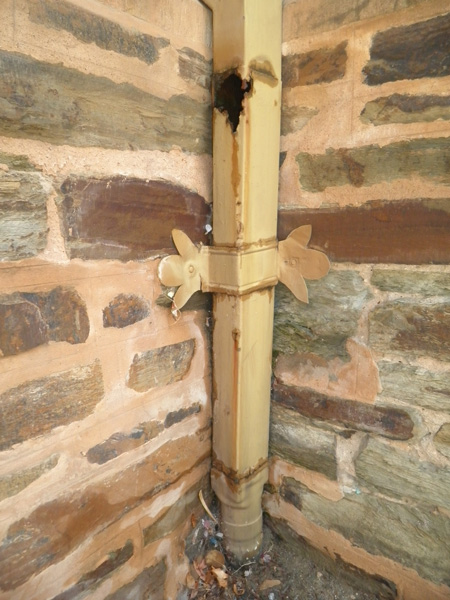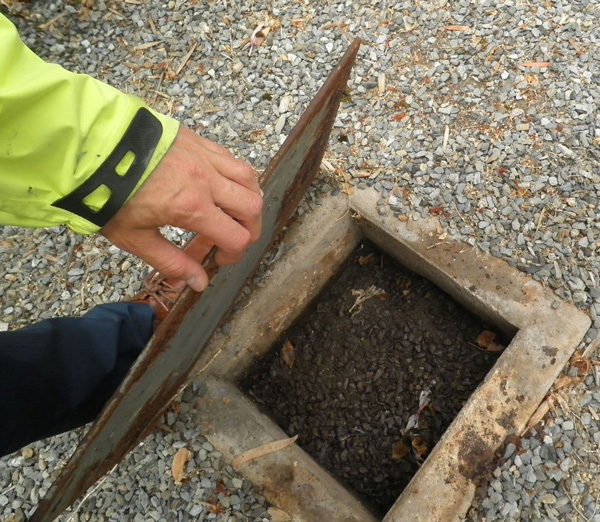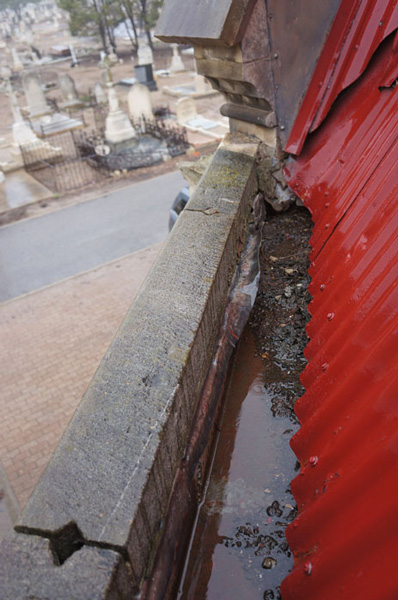‘A Stitch in Time – Guidance Notes in Maintaining your Place of Worship’
Guidance Note 3 – Rainwater Disposal
The roof finishes and flashings should efficiently shed water. The rainwater goods – gutters, downpipes and rainwater heads – manage that water by disposing of it clear of the walls and footings. It is particularly important that the top of the main walls be protected as this is the point where the timber roof structure bears onto the walls and damage to the structure at this point by water ingress can be extremely costly.

Damage to the render at the bottom of the raking abutment wall shown above has resulted in saturation of the wall next to the box gutter evidenced by the dampness and moss growth on the outside face of the wall seen below…

Saturation of the ground at the base of the walls and footings can also lead to major structural problems as the earth around the foundations can be washed away. Rainwater goods therefore need to be kept in good order.

Rusted cast iron rainwater pipe with a galvanised pipe fitted on top. While cast iron is durable it is prone to rust if not adequately maintained.
Cast iron was the strongest and longest lasting common material traditionally used for rainwater goods. Adelaide’s Cathedrals and the early, most prestigious churches in the state would have had cast iron gutters and down pipes.

Cast iron rainwater head precariously fixed. If this were to fall serious injury may result.
Cast iron rainwater goods where quickly superseded by galvanised steel rainwater goods which have less than half the life expectancy of cast iron.

A galvanised steel downpipe rusted through.
Both cast iron and heritage galvanised steel need to be well maintained. This requires that gutters and downpipes be cleaned out and inspected at least twice annually and the underground drainage be surveyed (using CCTV cameras) at least every 15 to 20 years. Where trees grow close to churches their roots can damage drains leading to saturation of the soil around footings. Heavy traffic can cause vibrations that can eventually cause old drainage pipes to collapse causing blockages that may take years to become apparent. In that time soil can be washed away beneath buildings and reactive soils can lead to movement of footings and cracking to external walls.

A drainage inspection pit full of gravel, and…

… another inspection pit containing empty beer bottles. It is important that drainage runs are inspected regularly and cleared out when necessary.
High level concealed box gutters present particular problems as it usually isn’t possible to see when they are blocked. It is good practice to have overflows installed to warn when the downpipe is blocked and water is backing up in the gutter, but even when fitted the overflows themselves become choked if box gutters aren’t checked and cleared out regularly. When box gutters overflow they often discharge water inside the building without it being immediately apparent.

A blocked box gutter. Note the damaged lead flashing and the build up of leaf debris and dirt in the gutter.
There can also be problems where rainwater pipes work loose and water discharges directly down the face of walls. If not attended to quickly the walls become saturated and damp seeps through to the inside finishes and timber structure.

The rainwater pipe from this box gutter is no longer connected so that water has been running directly down the face of the wall for some time. Note the cement pointing preventing the stonework from breathing and the white salt residue deposited where water has been evaporating from the stone surface. The situation is made worse by cracks in the cement pointing that will be allowing more moisture to penetrate. If this situation at the head of the wall is allowed to persist it will lead to deterioration of the underlying roof structure which will be very expensive to repair.
Conclusion
If you were to do nothing else to maintain your church building I strongly recommend that you inspect your gutters, rainwater heads and downpipes, as well as your underground drainage regularly and attain to any blockages or damage as a matter of urgency.
This guidance note only provides basic advice on what to look out for when reviewing your church rainwater disposal system. If you are in any doubt about the condition of your church fabric contact a well-respected heritage architect who has experience in dealing with church buildings to advise on a suitable course of action.




